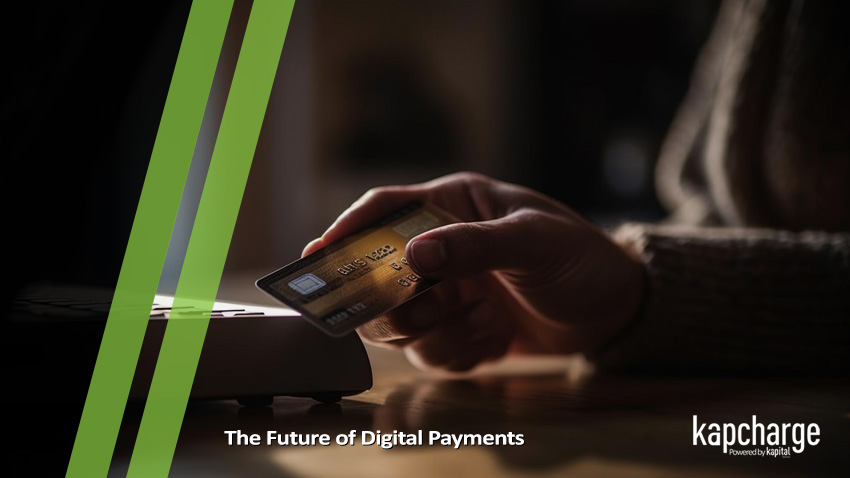
New Year, New Payment Solutions: How Kapcharge Is Innovating in 2025
February 3, 2025
Case Study: Kapcharge’s ACH Save Time and Money
February 10, 2025The digital payments landscape is evolving rapidly, driven by technological advancements, shifting consumer expectations, and regulatory changes.
As businesses and consumers continue to embrace seamless, secure, and fast payment solutions, 2025 is set to be a defining year for the industry. Here are the key trends shaping the future of digital payments in 2025:
1. Real-Time Payments Becoming the Standard
Speed and efficiency are at the forefront of digital payments. Real-time payment networks, including solutions like Visa Direct and Interac e-Transfer, are gaining widespread adoption. Businesses and consumers expect instant transactions, reducing reliance on traditional banking hours and delays. This trend is particularly crucial for gig workers who need immediate access to earnings, payroll processing that eliminates waiting periods, and cross-border transactions that currently suffer from extended processing times and high fees. Expanding real-time payment systems will likely lead to more seamless financial experiences and improved cash flow management for businesses and individuals.
2. Expansion of Central Bank Digital Currencies (CBDCs)
Governments and financial institutions worldwide are exploring the implementation of Central Bank Digital Currencies (CBDCs). Countries like China and the European Union are leading the charge in testing digital currencies that offer the benefits of traditional money with enhanced security and transparency. The Bahamas has already pioneered this space with the Sand Dollar, a digital representation of the Bahamian dollar, holding the same rights as physical banknotes and coins. Designed for mobile wallet platforms, the Sand Dollar is a true legal tender backed by foreign reserves, unlike cryptocurrencies, which are stored-value digital assets. In 2025, more pilot programs and regulatory frameworks are expected to shape the future of CBDCs, enabling faster and more efficient transactions while reducing dependence on cash. CBDCs also have the potential to enhance financial inclusion by providing digital currency access to unbanked populations and creating a more resilient financial ecosystem that is less susceptible to fraud and counterfeiting.
3. Biometric Authentication for Enhanced Security
As cybersecurity threats evolve, biometric authentication is becoming integral to digital payments. Fingerprint scanning, facial recognition, and voice authentication are expected to replace traditional passwords and PINs, offering a more secure and convenient payment experience. This shift not only enhances security by reducing the risk of password-related breaches but also improves the user experience by eliminating the need to remember multiple credentials. Businesses must adopt these technologies to enhance trust, minimize fraud, and align with regulatory requirements, emphasizing strong customer authentication (SCA).
4. Growth of Embedded Payments
Embedded finance is revolutionizing the way payments are made. Businesses are integrating payment capabilities directly into their platforms, eliminating the need for third-party gateways. Whether through e-commerce, ride-sharing apps, or financial services, seamless embedded payments will enhance user experience and drive customer loyalty. In 2025, we will see more businesses leveraging APIs to incorporate payments into their services effortlessly, making transactions more seamless for users. This trend also allows for improved data insights, enabling companies to offer personalized financial services based on customer behaviour.
5. Increased Adoption of AI and Machine Learning in Fraud Prevention
AI and machine learning are crucial in detecting and preventing payment fraud. In 2025, financial institutions and payment processors will leverage advanced AI models to identify suspicious transactions in real-time, reducing fraud risks while ensuring legitimate transactions go through smoothly. AI-driven fraud prevention systems will continuously learn from transaction patterns, helping financial institutions quickly adapt to new threats. These technologies will also enhance customer verification processes, improving overall security without compromising user experience.
6. Sustainable and Green Payments
Sustainability is becoming a key consideration in the payments industry. Companies are exploring eco-friendly payment options, such as digital wallets and virtual cards, to reduce the carbon footprint associated with traditional plastic cards and paper receipts. Financial institutions are also launching initiatives to track and offset transaction carbon emissions. The adoption of sustainable payment practices will not only reduce environmental impact but also attract eco-conscious consumers who prefer businesses that prioritize sustainability. Additionally, fintech firms are exploring blockchain solutions that use less energy, promoting greener alternatives to traditional banking systems.
7. Cross-Border Payments Revolution
Cross-border transactions have historically been slow and costly, but 2025 will see significant improvements in international payment solutions. Adopting blockchain technology, real-time settlement systems and interoperability between different financial networks will make cross-border payments faster, cheaper, and more accessible. Businesses that operate internationally will benefit from reduced transaction fees, increased transparency, and improved efficiency, helping them quickly expand into new markets. Additionally, advancements in AI-driven compliance systems will help navigate complex regulatory environments, ensuring smoother international transactions.
8. The Evolution of Buy Now, Pay Later (BNPL)
BNPL services continue to grow, with more businesses offering flexible financing options at checkout. However, 2025 will bring stricter regulations to ensure responsible lending and consumer protection. Expect BNPL providers to enhance transparency and improve risk assessment models. As more consumers use BNPL services, financial institutions will integrate AI-powered credit assessment tools to determine borrower risk in real-time. Additionally, businesses will explore new ways to integrate BNPL into diverse industries beyond retail, such as healthcare and education, making high-value services more accessible to consumers.
9. Open Banking and API-Driven Payments
Open banking is transforming the financial sector by enabling secure data sharing between banks and third-party providers. API-driven payments will facilitate seamless transactions, giving consumers more control over their financial data while fostering innovation in fintech services. In 2025, we can expect further advancements in open banking, allowing users to access a broader range of financial products tailored to their needs. Businesses will leverage open banking to provide more innovative financial services, including automated savings, personalized financial advice, and seamless multi-account payment management, improving overall customer satisfaction.
Conclusion
The future of digital payments in 2025 is shaped by innovation, security, and efficiency. Businesses that stay ahead of these trends will be well-positioned to offer enhanced payment experiences while maintaining compliance with evolving regulations. Whether through real-time payments, biometric authentication, or AI-driven fraud prevention, the next wave of digital payment solutions will continue to redefine how money moves globally.
As the landscape evolves, companies must adapt to meet customer expectations and leverage emerging technologies to stay competitive. The future of digital payments is here—are you ready?
If your business wants to stay ahead of the digital payments revolution, now is the time to explore cutting-edge solutions. Contact us today to learn how to integrate the latest payment innovations into your business strategy.





